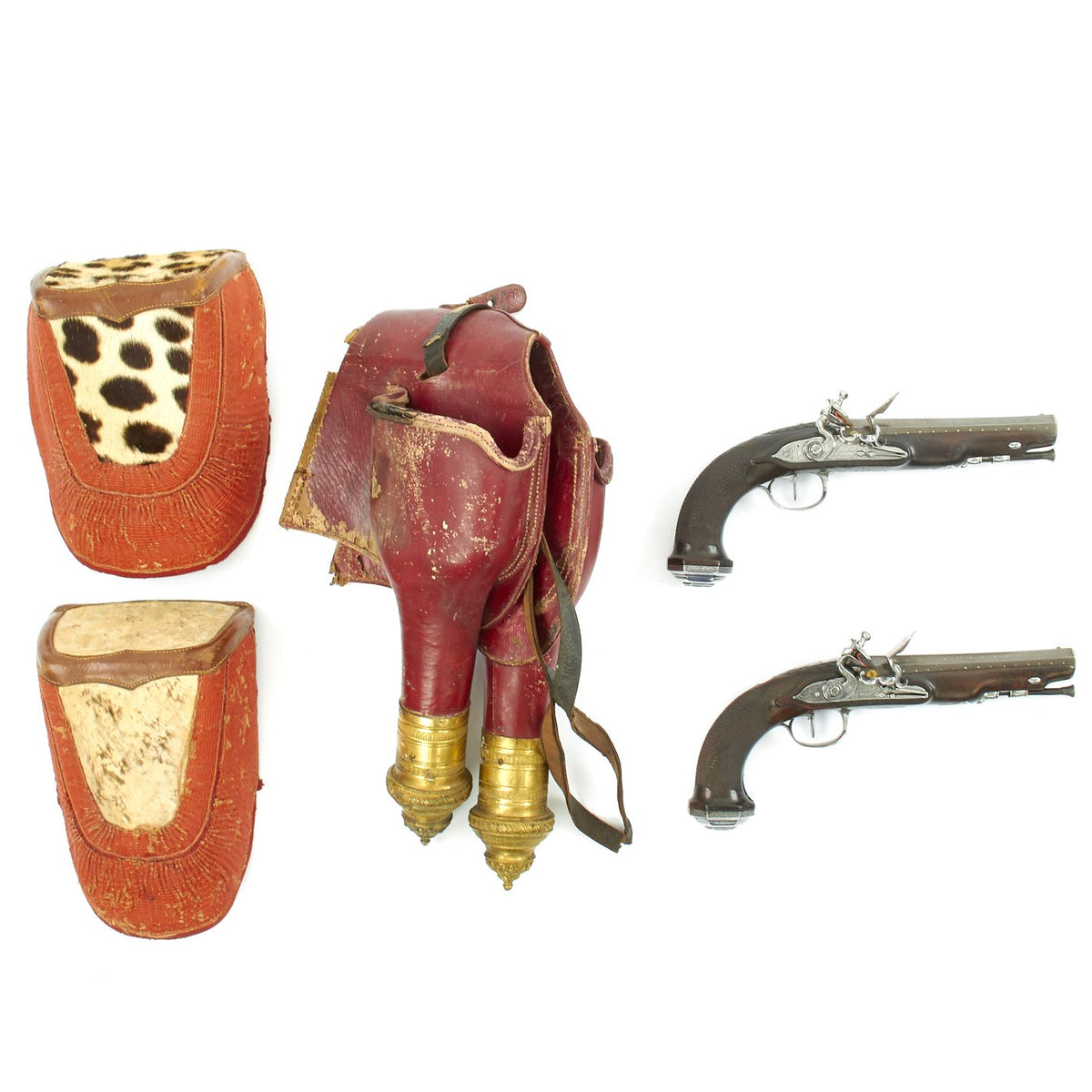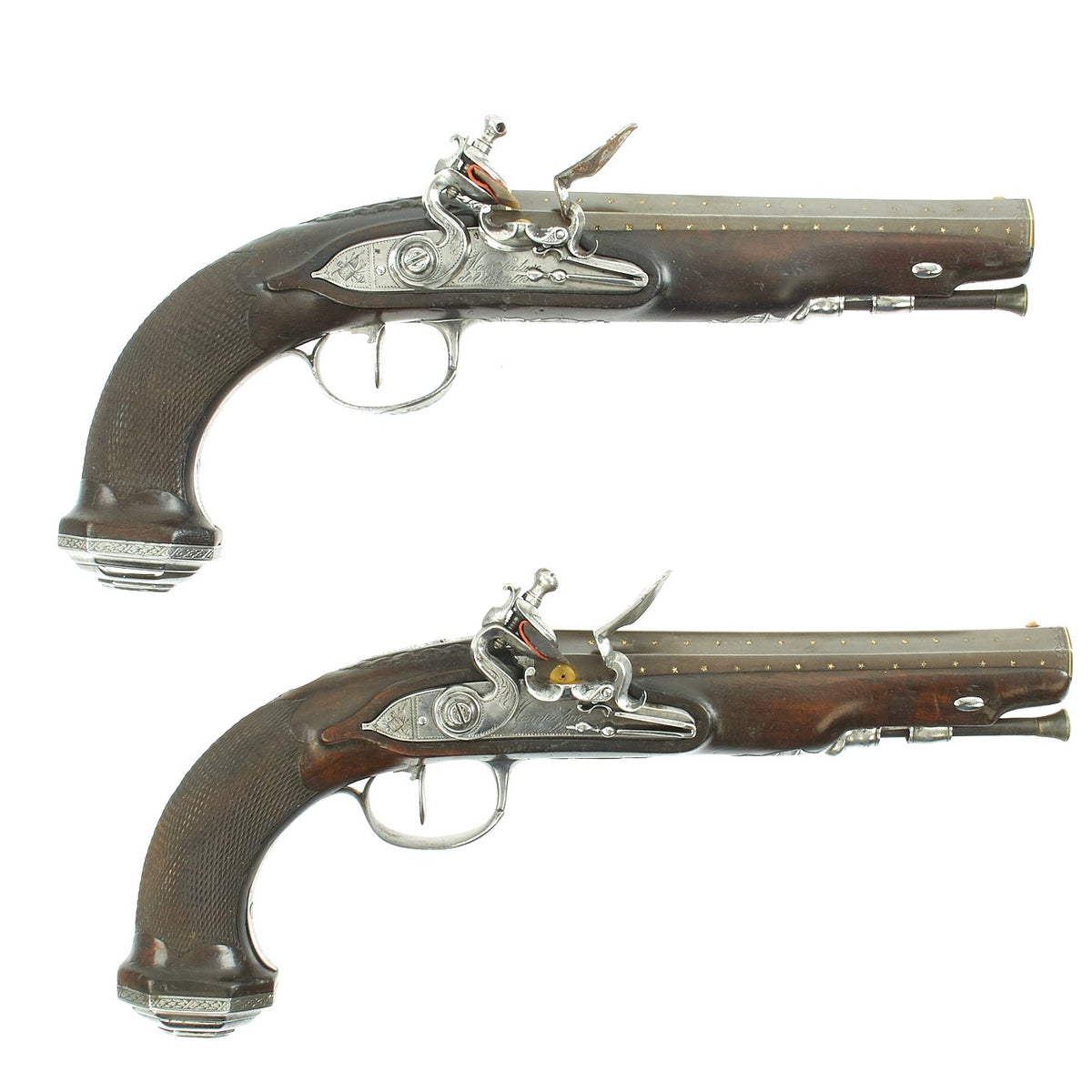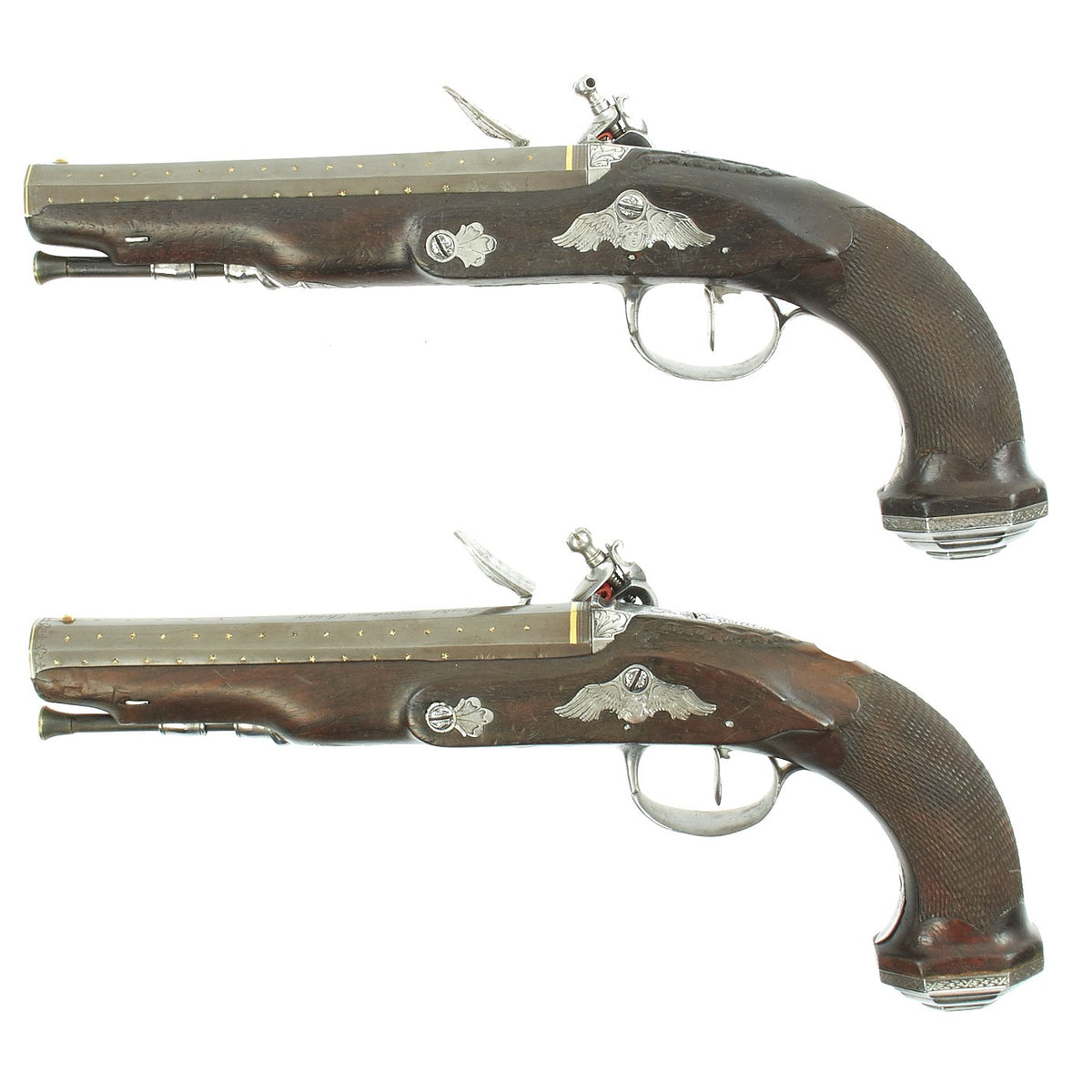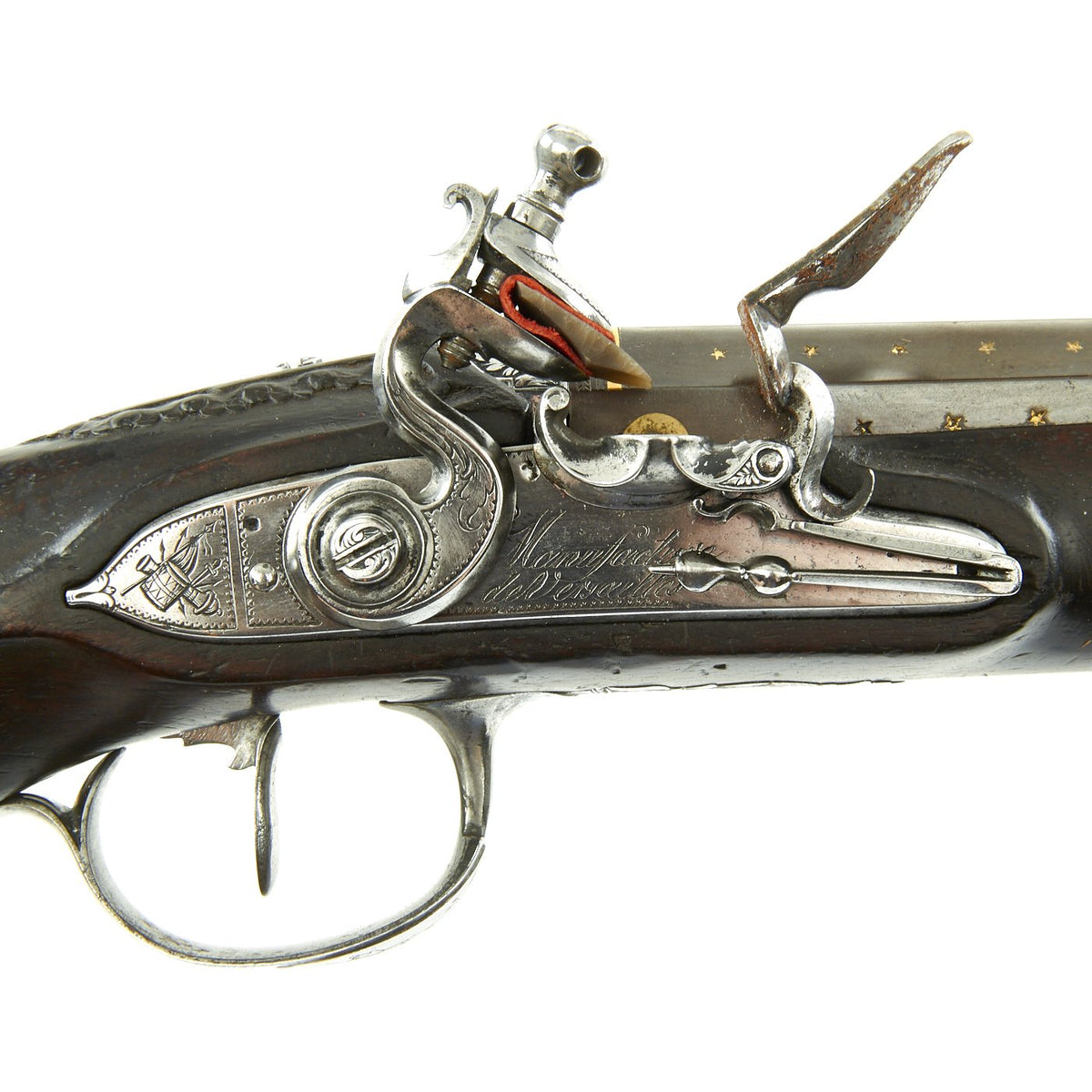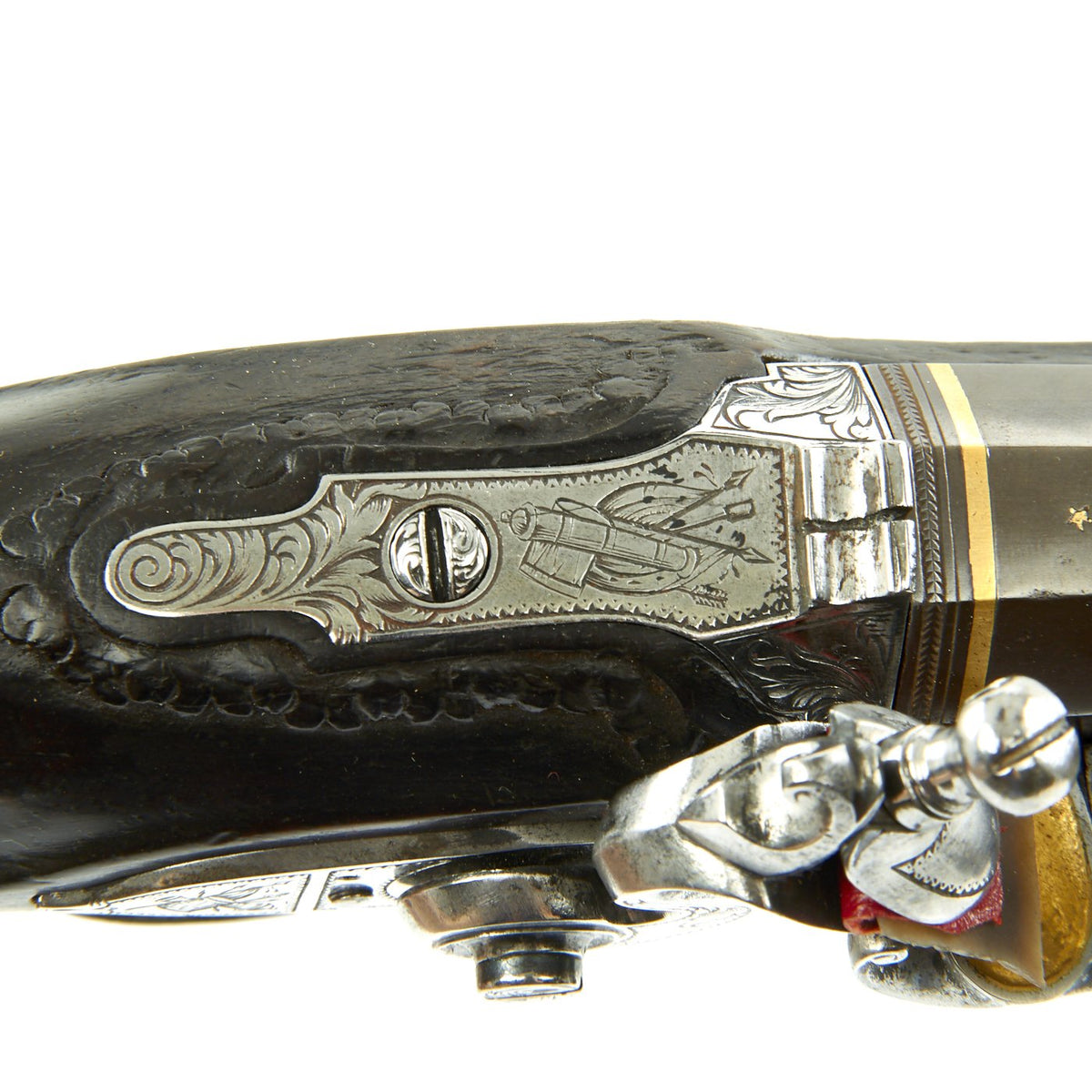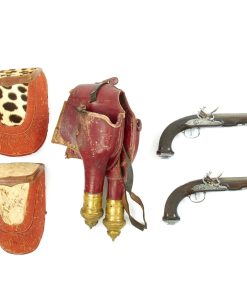Original French Napoleonic Boutet Flintlock Pistols with Saddle Holster of General Pierre-Louis Binet de Marcognet Original Items
$ 34.995,00 $ 8.748,75
Original Items: One-of-a-kind. Just acquired from a private collection, these have never before been offered on the open market!
Nicholas-Noël Boutet (1761-1833) was one of the great names in the history of gun-making and was charged by Napoleon with creating richly-decorated arms for presentation to military heroes and foreign heads of state. Some of the guns produced in his workshop are considered to be the finest high-art firearms ever created. Boutet was responsible for the manufacture of a great number of firearms during his life-time as an ‘arquebusier’ (gun-maker). Some of his weapons were exceedingly expensive; a set of nine guns and a pair of pistols made for King Charles IV of Spain, who abdicated in 1808, cost 130,000 francs.
Boutet’s work is rare. Examples may be seen in the UK at Windsor Castle, the Tower of London, the Wallace Collection, the Victoria & Albert Museum, and in the City Museum and Art Gallery, Glasgow. There are, of course, many in France and in private ownership. There are also examples in Moscow and Leningrad, and several fine Boutet pieces in the Metropolitan Museum of Art in New York.
These are a matched pair of French Napoleonic Wars flintlock officer pistols made by Nicholas-Noël Boutet. They are of moderate size and fitted with octagonal 6.75 inch barrels that are deeply blued and covered with inlaid gold stars. The barrels, in approximately .6″ caliber, are both signed Boutet Directeur Artiste while the lock faces are signed Manufacture de Versailles. They feature engraved swan cocks, front and rear sights, decorative barrel tangs and engraved stepped butt caps. The polished steel mounts are all finely engraved. The butt stocks of each pistol are beautifully checkered and remain crisp. Both pistol have classic Boutet gold filled powder pans and touch holes. The pistols measure approximately 12.5 inches in overall length.
They are accompanied by a pair of red Moroccan leather saddle holsters that have incredible leopard fur liners and gilded mounts. Each holster is connected to the other for the purpose of riding on either side of a horse’s neck. Both have separate leather lined top covers to shelter the pistols from adverse weather. There is an old paper label inside one of these covers and written in copper plate French handwriting it is stated that these belonged to General Pierre-Louis Binet de Marcognet.
Pierre-Louis Binet de Marcognet (14 November 1765 – 19 December 1854) joined the French army in 1781 as an officer cadet and fought in the American Revolutionary War. During the French Revolutionary Wars he fought in the Army of the Rhine and was wounded at First and Second Wissembourg. After being dismissed from the army for a year and a half for having noble blood, he resumed his military career and was wounded at Biberach and Kehl. Promoted to lead the 108th Line Infantry Demi-Brigade, he was in the thick of the fighting at Hohenlinden in 1800, where he was wounded and captured.
At the start of the Napoleonic Wars, Marcognet was a general officer commanding a brigade in Marshal of France Michel Ney’s corps. He led his troops at Günzburg, Elchingen, and Scharnitz in 1805. In the 1806-1807 campaign, he led his brigade at Jena, Magdeburg, Eylau, Guttstadt-Deppen, and Friedland. After Ney’s corps transferred to Spain, he fought at Tamames, Alba de Tormes, Ciudad Rodrigo, Almeida, Bussaco, Torres Vedras, Casal Novo, and Fuentes de Onoro.
Marcognet commanded a division in the Italian campaign of 1813-1814, fighting at Caldiero, Boara Pisani, the Mincio, and other actions. In 1815, he led a division at Waterloo where it was broken by cavalry after an initial success. Marcognet is one of the names inscribed under the Arc de Triomphe, on Column 7.
At the Battle of Waterloo on 18 June 1815, Marcognet commanded the 3rd Division in Jean-Baptiste Drouet, Comte d’Erlon’s I Corps. Antoine Nogues’ 1st Brigade consisted of the 21st and 46th Line Infantry Regiments. Jean-Georges Grenier’s 2nd Brigade included the 25th and 45th Line Infantry Regiments. There were a total of eight battalions. The division was posted in the first line on the right flank, with Pierre François Joseph Durutte’s 4th Division on its right and François-Xavier Donzelot’s 2nd Division on its left. According to historian David G. Chandler, Marcognet’s 4,200-man division was formed with seven battalions each deployed in three-deep line with four pace intervals between battalions. The formation was 200 yards (183 m) or 200 men wide while its depth was 52 yards (48 m). The French called this tactical formation the Colonne de Division par Bataillon.
After d’Erlon’s attack commenced, Joachim Jerome Quiot du Passage’s 1st Division encountered the British 95th Rifles in the gravel pit and inclined to its right. This movement caused the 2nd Division to hesitate and Marcognet’s division surged several hundred yards into the lead. The Netherlands 7th and 8th National Militia Battalions engaged in a fire fight with the French skirmishers, taking some loss. Suddenly, their opponents fell back to reveal the front rank of Marcognet’s column at close range. The French fired a tremendous volley from 400 muskets which inflicted heavy losses on the militiamen, who immediately retired on the second line. The men of Rogers’ nearby battery abandoned their position and spiked one of their own guns. As Denis Pack ordered his British brigade forward from the second line, the battalion of the 45th Line in Marcognet’s front rank found itself being attacked by the 92nd Foot, a Scottish Highland regiment. The Highlanders fired into the mass before them at a range of 20 yards (18 m) but their volley was not fully effective because of their four-deep line formation. Overlapping the 92nd on both flanks, the 45th Line fired another crushing volley, throwing the Highlanders into confusion. At this moment, the British division commander Thomas Picton fell dead from a bullet in his forehead. The 3rd Division began to shout, “Victory”.
Suddenly, the 2nd Scots Greys Dragoon Regiment appeared behind the 92nd and plowed into Marcognet’s division. The effect was catastrophic. The British cavalrymen, mounted on large horses, rained sword-cuts on the French foot soldiers as they hewed a bloody path through the formation. During the one-sided melee, the 45th Line lost its eagle. The Scots Greys rode completely through the 3rd Division, but were repulsed by one of Durutte’s brigades. Those Frenchmen who were untouched by British heavy cavalry swords immediately fled back toward their own lines chased by the British and Netherlands infantry. Altogether, about 3,000 prisoners were gathered up from d’Erlon’s four divisions, all of which were broken by cavalry. Late in the day, Marcognet got together a rump of his division in order to support the final assault on La Haye Sainte. Shortly before the defeat of the Old Guard’s final attack, the remnant of the 3rd Division rallied to attack one last time.
Marcognet was retired from the army on 9 September 1815 and not employed for 15 years. After the July Revolution of 1830, the new government admitted him into the army reserve on 7 February 1831. His final retirement came on 1 May 1832. He died in Paris on 19 December 1854 and is buried in the Père Lachaise Cemetery with his wife, Julie Catherine Le Monnier (1795–1866).
Approximate Specifications-
Year of Manufacture: 1800-1815
Caliber: .6″
Barrel Length: 6.75 Inches
Overall Length: 12.5 Inches
Action type: Flintlock
Feed System: Muzzle Loading
Fast Shipping with Professional Packaging
Thanks to our longstanding association with UPS FedEx DHL, and other major international carriers, we are able to provide a range of shipping options. Our warehouse staff is expertly trained and will wrap your products according to our exact and precise specifications. Prior to shipping, your goods will be thoroughly examined and securely secured. We ship to thousands clients each day across multiple countries. This shows how we're dedicated to be the largest retailer on the internet. Warehouses and distribution centres can be located throughout Europe as well as the USA.
Note: Orders with more than one item will be assigned a processing date depending on the item.
Before shipping before shipping, we'll conduct a thorough inspection of the items you have ordered. Today, the majority of orders will be delivered within 48 hours. The delivery time will be between 3-7 days.
Returns
The stock is dynamic and we cannot completely manage it because multiple stakeholders are involved, including our factory and warehouse. So the actual stock may alter at any time. It's possible that you may not receive your order once the order has been made.
Our policy is valid for a period of 30 days. If you don't receive the product within 30 days, we are not able to issue a refund or an exchange.
You can only return an item if it is unused and in the same state as the day you received it. You must have the item in its original packaging.
Related products
Uncategorized
Uncategorized
Australian WWII Owen MK1 Machine Carbine SMG Custom Fabricated Replica with Sling Original Items
Uncategorized
Uncategorized
Uncategorized
Uncategorized
Uncategorized
Uncategorized
Armoured Fighting Vehicles of the World: AFVs of World War One (Hardcover Book) New Made Items
Uncategorized
Armored Burgonet Helmet & Polearm from Scottish Castle Leith Hall Circa 1700 Original Items
Uncategorized
Angolan Rebel 1970s era 60mm Inert Display Mortar from Angolan Civil War Original Items
Uncategorized
Uncategorized
Uncategorized
Uncategorized
Uncategorized
Uncategorized
Uncategorized
Uncategorized
Uncategorized
